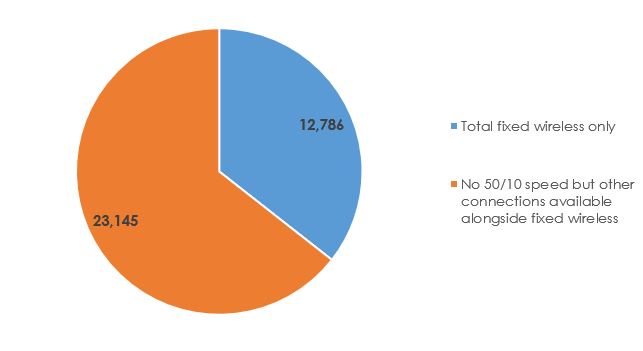Connectivity in Northwestern Ontario: A House Digitally Divided Cannot Stand
May 5, 2020 - This blog first appeared in The Walleye Magazine, May issue

Is the music from your Spotify account playing in the background without any connection issues? Are you able to hold a Zoom meeting and maintain a steady connection? Is the meme your co-worker sent loading quickly?
Unfortunately, this is not the case for everyone.
According to the Canada Radio-television and Telecommunications Commission (CRTC), most Canadian households and businesses ought to have access to a minimum of 50/10 mbps by 2021 – 50 mbps download and 10 mbps upload. In 2018, there was a total of 35,931 dwellings in Northwestern Ontario without 50/10 mbps. To put this data into scale, 35,931 roughly translates to the following communities’ populations combined: Kenora, Dryden, Fort Frances, and Sioux Lookout.
Breaking this data down further, figure 1 below shows that of those 35,931 dwellings without 50/10, only 35.6 per cent relied on total fixed wireless only. Fixed wireless internet uses cellphone networks and the average price per mbps is high compared to other types of connections.
Figure 1: Total Dwellings without 50/10 mbps Internet, Northwestern Ontario

Source: Cartovista & CRTC. 2018. “Fixed Internet Access and Transport Maps.” https://crtc.gc.ca/cartovista/fixedbroadbandandtransport_en/. Author’s calculations.
Indeed, having adequate internet accessibility (both in terms of speed as well as available connections), plays a key role in our ability to work effectively from home. Occupations such as educators make up 4.5 per cent of the Thunder Bay district employed workforce. Individuals in these occupations utilize tools like Brightspace/D2L and Blackboard, which are platforms used by teachers and students for online learning.
For us at Northern Policy Institute, digital connectivity while we all work from home aids us in accessing online resources such as Statistics Canada and other literature works. It also is important for our end-of-the-month movie watching event via Netflix Party. Just because we’re physical distancing doesn’t mean we should be social distancing!
Of course, not everyone can work from home.
Taking a look at the top 10 occupations based on three-digit national occupational classification (NOC) codes for the Thunder Bay district, there are various occupations that are unable to be performed at home. Retail salespersons, cleaners, nurses, and food counter attendants are just some examples from this top 10 list.
However, the internet still plays an important role in these types of occupations. For example, local restaurants such as Red Lion, Rebel Salad, and Curry Up Now Indian Kitchen utilize online ordering systems and/or phone apps. Or for health occupations that provide telemedicine services.
Overall, it’s clear that COVID-19 has created interruptions in both the personal and professional lives of residents here in Thunder Bay and elsewhere. It’s shown that accessible and adequate digital connectivity is a must for those who work from home. But it’s also shown that even for those who can’t work from home, the internet still plays a role in how businesses and organizations can operate.
Write for us
Rachel Rizzuto is the Research Manager at NPI.
The content of Northern Policy Institute’s blog is for general information and use. The views expressed in this blog are those of the author and do not necessarily reflect the opinions of Northern Policy Institute, its Board of Directors or its supporters. The authors take full responsibility for the accuracy and completeness of their respective blog posts. Northern Policy Institute will not be liable for any errors or omissions in this information, nor will Northern Policy Institute be liable for any detriment caused from the display or use of this information. Any links to other websites do not imply endorsement, nor is Northern Policy Institute responsible for the content of the linked websites.
Northern Policy Institute welcomes your feedback and comments. Please keep comments to under 500 words. Any submission that uses profane, derogatory, hateful, or threatening language will not be posted. Please keep your comments on topic and relevant to the subject matter presented in the blog. If you are presenting a rebuttal or counter-argument, please provide your evidence and sources. Northern Policy Institute reserves the right to deny any comments or feedback submitted to www.northernpolicy.ca that do not adhere to these guidelines.

Connectivity in Northwestern O
Posted By Jennifer McKibbon on 11/3/2020 10:57:16 AM
is there data to show how many/what percentage of the 35,931 dwellings in NWOntario without the CRTC standard 50/10 connection are located in First Nation communities?